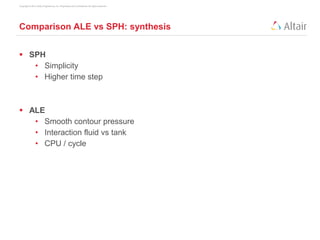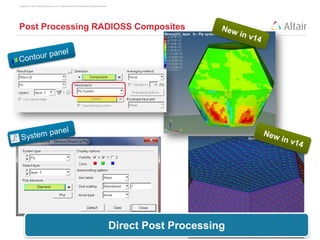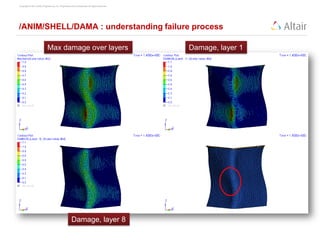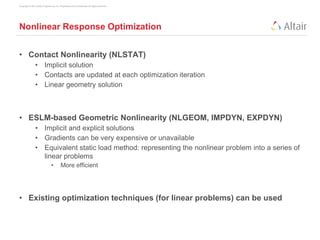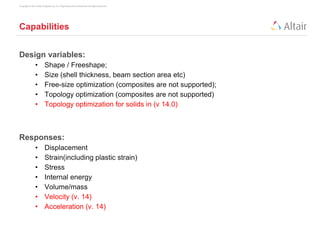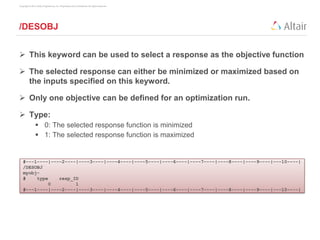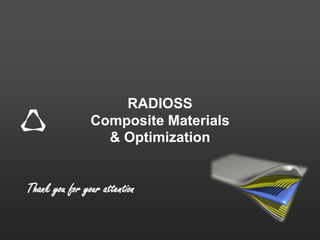RADIOSS - Composite Materials & Optimization
- 1. 2015 European Altair Technology Conference September 29 to October 1 | Paris Technical Seminar RADIOSS Composite Materials & Optimization Pierre-Christophe Masson – [email protected] Jean-Baptiste Mouillet – [email protected] Juan Pedro Berro Ramirez – [email protected] Erwan Mestres – [email protected] Vincent Diviné – [email protected] Join, Contribute, Exchange See full agenda at www.altairatc.com/europe
- 2. Copyright © 2013 Altair Engineering, Inc. Proprietary and Confidential. All rights reserved. Abstract Lightweight Design has always been important for some manufacturers but today, it is becoming increasingly essential to fit the future resource efficiency and emission standard requirements. Optimization & Composite materials are two strategic keys to develop lightweight designs. However, their applications to highly non-linear analyses, such as crash and impacts, are quite complex topics. This workshop will showcase the abilities regarding Optimization & Composite with RADIOSS, the Altair solver for highly non-linear analyses, how to setup and review composite models, how to perform and optimize Composites parts using RADIOSS.»
- 3. 01 Composite Initialization 02 Fluid Modeling 03 Post Processing of Composite Materials 04 Optimization 05 User Failure Criteria RADIOSS Composite Materials & Optimization
- 4. Copyright © 2013 Altair Engineering, Inc. Proprietary and Confidential. All rights reserved. About RADIOSS Structural analysis solver for highly non-linear problems under dynamic loadings. • High Scalability, Quality and Robustness • Supports multiphysics simulation and advanced materials • Used across all industries to improve crash, safety and manufacturability • For 20+ years an established standard for automotive crash and impact
- 5. Copyright © 2013 Altair Engineering, Inc. Proprietary and Confidential. All rights reserved. RADIOSS : The Standard behind Structure Safety Multiphysics Analysis Crash and Safety Drop & Impact Blast & Hydrodynamic Impact Fluid- Structure Interaction Terminal Ballistic Forming & Composites Mapping and Optimization
- 6. Copyright © 2013 Altair Engineering, Inc. Proprietary and Confidential. All rights reserved. RADIOSS: Overview within HyperWorks HyperWorks HyperMesh Meshing Pre-Processing/Model Checker HyperCrash Pre-Processing/Mapping Model Checker RADIOSS Analysis of highly Non Linear problems under Dynamic loadings HyperView/HyperGraph Post-Processing HyperWorks Partners CAD & Mfg Interoperability OptiStruct Optimization (ESLM) … HyperStudy DOE, Optimization, Robustness studies HyperForm Forming
- 7. RADIOSS Composite Modeling New Stack & Ply possibility Orientation Review Composite Forming Preliminary Optimization 01 Composite Initialization
- 8. RADIOSS Composite Modeling New Stack & Ply possibility Orientation Review Composite Forming Preliminary Optimization 01 Composite Initialization
- 9. Copyright © 2013 Altair Engineering, Inc. Proprietary and Confidential. All rights reserved. Composite Zone-Based Modeling position PART 1 PART 2 PART 3 PART 4 PART 5 1 Ply 0° Ply 90° Ply 45° Ply 90° Ply 0° 2 Ply 0° Ply 0° Ply 90° Ply 0° Ply 0° 3 Ply 0° Ply 0° Ply 0° 4 Ply 90° Ply 0° Ply 90° 5 Ply 90° 6 Ply 45°
- 10. Copyright © 2013 Altair Engineering, Inc. Proprietary and Confidential. All rights reserved. Composite Ply-Based Modeling1Laminate PLY 1 Ply 45° PLY 2 Ply 90° PLY 3 Ply 0° PLY 4 Ply 0° PLY 5 Ply 90° PLY 6 Ply 45°
- 11. Copyright © 2013 Altair Engineering, Inc. Proprietary and Confidential. All rights reserved. Composites Technology - Ply Based Modeling A Composite Part is made up of “n” Plies and One Laminate No Data Duplication Direct Relationship to the Manufacturing Process Ply Based Modeling Process Define Ply Shapes and Related Ply Data Define Stacking Sequences Design Change Requires only 1 Update P1 45 P2 90 P3 -45 P4 0 P6 90 P7 45 P5 - 45 Stack Table Ply Mat Thk Theta P7 M1 0.01 45 P6 M1 0.01 90 P5 M1 0.01 -45 P4 M1 0.01 0 P3 M1 0.01 -45 P2 M1 0.01 90 P1 M1 0.01 45
- 12. Copyright © 2013 Altair Engineering, Inc. Proprietary and Confidential. All rights reserved. Property sets for Composite Modeling Orthotropic Shell: TYPE9 SH_ORTH Composite Shell: TYPE10 SH_COMP Sandwich Shell: TYPE11 SH_SAND Ply-based Sandwich Shell: TYPE17 STACK TYPE19 PLY Composite Thick Shell: TYPE22 TSH_COMP Orthotropic Solid: TYPE6 SOL_ORTH General Solid: TYPE14 SOLID Sandwich Shell: /PROP/TYPE11 (SH_SAND) • 4 and 3 nodes sandwich shell elements • N layers with • Orthotropic layers (two directions) • Different orientation of each layer • Unequal thickness of layers • Different materials for layers • Material law can be : • Law 25 (composite shell) • Law 27 (brittle elastic plastic) • Law 36 or 60 (tabulated piecewise non linear elastic-plastic) • User’s laws • Same material law type for the property
- 13. Copyright © 2013 Altair Engineering, Inc. Proprietary and Confidential. All rights reserved. Property set for shell elements Sandwich Shell: /PROP/TYPE11 (SH_SAND) • Example #---1----|----2----|----3----|----4----|----5----|----6----|----7----|----8----|----9----|---10----| /PROP/SH_SANDW/1 Composite_L7_UD # Ishell Ismstr Ish3n Idril 12 0 0 0 # hm hf hr dm dn 0 0 0 .1 0 # N Istrain Thick Ashear Ithick Iplas 7 1 2.5 0 0 1 # Vx Vy Vz Skew_ID Iorth Ipos 1 0 0 0 1 0 # Phi t Z mat_ID 0 .5 0 11 45 .25 0 11 -45 .25 0 11 90 .5 0 11 -45 .25 0 11 45 .25 0 11 0 .5 0 11 #---1----|----2----|----3----|----4----|----5----|----6----|----7----|----8----|----9----|---10----| Number of Layers Total Thickness Reference Orientation Plies Definitions
- 14. Copyright © 2013 Altair Engineering, Inc. Proprietary and Confidential. All rights reserved. Composite Material : /MAT/LAW25 (CRASURV) Model • Linear elastic behavior until the yield stress value followed by a plastic behavior • Lamina yield surface is the TSAI-WU yield criteria function • Plastic hardening function of plastic work defined independently for each direction • Strain rate dependency • Residual stress value after stress damage (without element deletion) • Failure model in tensile, maximum plastic work and Tsai-Wu criteria. • Composite fabric or fibers in the plane 12. Elements • Solid, Thick-shell and Shell elements.
- 15. RADIOSS Composite Modeling New Stack & Ply possibility Orientation Review Composite Forming Preliminary Optimization 01 Composite Initialization
- 16. Copyright © 2013 Altair Engineering, Inc. Proprietary and Confidential. All rights reserved. Stack & Ply properties for shell elements Ply-based Sandwich shell: /PROP/TYPE17 (STACK) • Sandwich 4 and 3 nodes shell elements • Layer is defined by plies • Ply information: /PROP/TYPE19 (PLY) • Material Law 25, 27, 36 or 60. • Direction • Thickness • Inter-ply material (not yet active) • Advantage : • Continuity of the ply, even if the total number of plies changes in terms of geometry. Stack = a “stack of plies”
- 17. Copyright © 2013 Altair Engineering, Inc. Proprietary and Confidential. All rights reserved. Stack & Ply properties for shell elements #---1----|----2----|----3----|----4----|----5----|----6----|----7----|----8----|----9----|---10----| /PROP/TYPE17/1 outer # Ishell Ismstr Ish3n Idril 12 0 0 0 # hm hf hr dm dn 0 0 0 .1 .1 # N Istrain Thick Ashear Ithick Iplas 3 0 0,0000 0 1 1 # VX VY VZ skew_ID Iorth Ipos 0 0 1 0 0 0 # Pply_IDi PHIi Zi 1 0 0 # Mint_IDi 200 # Pply_IDi PHIi Zi 2 90 0 # Mint_IDi 200 # Pply_IDi PHIi Zi 3 0 0 #---1----|----2----|----3----|----4----|----5----|----6----|----7----|----8----|----9----|---10----| /PROP/TYPE19/1 outer1 # mat_ID_i t delta_phi 13 1.0 0 1112 /PROP/TYPE19/2 outer2 # mat_ID_i t delta_phi 13 1.0 45 1114 /PROP/TYPE19/3 outer3 # mat_ID_i t delta_phi 13 1.0 0 1112
- 18. Copyright © 2013 Altair Engineering, Inc. Proprietary and Confidential. All rights reserved. Comparison between OS input and RADIOSS input $HMNAME LAMINATES 1"outer" $HWCOLOR LAMINATES 1 5 STACK 1 1 2 3 $$ $ + 3 $ /PROP/TYPE17/1 outer … # Pply_IDi PHIi Zi 1 0 0 # Mint_IDi # Pply_IDi PHIi Zi 2 90 0 # Mint_IDi # Pply_IDi PHIi Zi 3 0 0 $HMNAME PLYS 1"outer1" $HWCOLOR PLYS 1 57 PLY 1 13 1.0 0.0 YES + 1112 $ $HMNAME PLYS 2"outer2" $HWCOLOR PLYS 2 21 PLY 2 13 1.0 45.0 YES + 1114 $ $HMNAME PLYS 3“outer3" $HWCOLOR PLYS 3 61 PLY 3 13 1.0 0.0 YES + 1112 $ /PROP/TYPE19/1 outer1 # mat_ID_i t delta_phi 13 1.0 0 1112 /PROP/TYPE19/2 outer2 # mat_ID_i t delta_phi 13 1.0 45 1114 /PROP/TYPE19/3 outer3 # mat_ID_i t delta_phi 13 1.0 0 1112 OS RADIOSS
- 19. Copyright © 2013 Altair Engineering, Inc. Proprietary and Confidential. All rights reserved. Global material Global material properties are now automatically calculated Equivalent material based on the properties of the layup Membrane Bending A material for part definition is still needed (for pre and post treatment) The stability condition is recomputed Offset layup stability is improved Results may be changed within numerical sensitivity of the model Default option in v14, but it is possible to “go back”
- 20. RADIOSS Composite Modeling New Stack & Ply possibility Orientation Review Composite Forming Preliminary Optimization 01 Composite Initialization
- 21. Copyright © 2013 Altair Engineering, Inc. Proprietary and Confidential. All rights reserved. Order of the Stacking: Layers are stacked • from bottom to top • from first layer to last layer In HyperMesh: Mesh > Check > Elements > Normals Normal Orientation
- 22. Copyright © 2013 Altair Engineering, Inc. Proprietary and Confidential. All rights reserved. Elementary System Display of Element r,s,t vectors Can be used to Check Normals Or (r,s) system, especially for solid elements HyperMesh HyperCrash
- 23. Copyright © 2013 Altair Engineering, Inc. Proprietary and Confidential. All rights reserved. Check of Material Orientations Display of Material Orientations (in HyperCrash) Material Orientations
- 24. Copyright © 2013 Altair Engineering, Inc. Proprietary and Confidential. All rights reserved. Initialization of Orthotropy Direction Display of the initialization of orthotropy direction for shells element (in HyperCrash) • Angle of first direction of orthotropy relatively of first direction of the local reference frame (/INISHE/ORTH_LOC) • Angle for first axis of orthotropy relatively to given reference vector (/INISHE/ORTHO)
- 25. RADIOSS Composite Modeling New Stack & Ply possibility Orientation Review Composite Forming Preliminary Optimization 01 Composite Initialization
- 26. Copyright © 2013 Altair Engineering, Inc. Proprietary and Confidential. All rights reserved. Composite Forming Aims: 1) To provide a simple solution which gives tendencies • Simple set up with reduced numbers of input data • Accurate enough to give main tendencies • Fast enough to be used in an industrial context 2) Seamless crash model initialization with forming results Solutions: One Step solutions: Drape Estimator Multi Scale methods (MDS, KTex (CEDREM)) Incremental Computations
- 27. Copyright © 2013 Altair Engineering, Inc. Proprietary and Confidential. All rights reserved. HyperForm/Incremental RADIOSS Sandwich approach One part of shell elements with • One composite material • One multi-layers property To give tendancies No sliding between layers No coupling between warp and weft directions Independant Layers approach N parts of shell elements • One material law per layer • One property per layer • Contact between layers More accurate Sliding between layers Coupling between warp and weft directions Sandwich approach Independant Layers approach s11 s11 ~ 2 modeling approaches
- 28. Copyright © 2013 Altair Engineering, Inc. Proprietary and Confidential. All rights reserved. Crash Model Initialization Process 1. Forming Setup: • Die, Binder, Punch & Blank 2. Composite Setup: 3. Computation (RADIOSS) 4. Mapping Approach Selection: Dry or Resin Stacking definition Ply creation Material Orientation are mapped on the different layers 2nd Directions can be mapped for Fabric Blank type selection Composite Blank config selection Multilayered Automatic Creation of • Contact interfaces tools and blank(s) • Contact interface between layers • Post-treatment cards in engine
- 29. Copyright © 2013 Altair Engineering, Inc. Proprietary and Confidential. All rights reserved. Forming influence on Impact Reference Model Model initialized with fiber directions
- 30. RADIOSS Composite Modeling New Stack & Ply possibility Orientation Review Composite Forming Preliminary Optimization 01 Composite Initialization
- 31. Copyright © 2013 Altair Engineering, Inc. Proprietary and Confidential. All rights reserved. Preliminary Optimization Aims: Quickly Define Composite Patches before Performance Optimization Solution: Run OptiStruct Free Size optimization Convert OptiStruct result to RADIOSS
- 32. Copyright © 2013 Altair Engineering, Inc. Proprietary and Confidential. All rights reserved. Load Linearization Identification of the most important force peaks Forces extraction from RADIOSS Simulation Result using HyperView
- 33. Copyright © 2013 Altair Engineering, Inc. Proprietary and Confidential. All rights reserved. Equivalent OS Model Set Up MAT 8 1 PCOMPP & Laminate on each face Each laminate composed of 4 plies [0, 90, 45, -45] 3 Load collector corresponding for each force’s peak Inertia RELIEF active
- 34. Copyright © 2013 Altair Engineering, Inc. Proprietary and Confidential. All rights reserved. Equivalent OS Model Set Up Force Import: ANALYSIS FORCES
- 35. Copyright © 2013 Altair Engineering, Inc. Proprietary and Confidential. All rights reserved. Equivalent OS Model Set Up One Design Variable (freeSize) for each laminate Pattern repetition to get the same result on each face Loading is not symmetric Master Master Slaves Slave Objective Min Compliance Constraint Vol Frac < 50%
- 36. Copyright © 2013 Altair Engineering, Inc. Proprietary and Confidential. All rights reserved. Optimization Result Freesize Total thickness Ply 0° Ply 90° Ply 45° Ply -45°
- 37. Copyright © 2013 Altair Engineering, Inc. Proprietary and Confidential. All rights reserved. Optimization Result OptiStruct output fem
- 38. Copyright © 2013 Altair Engineering, Inc. Proprietary and Confidential. All rights reserved. Conversion to RADIOSS Using OptiStruct Non Linear analysis (NLGEOM, EXPDYN), OptiStruct model is converted into RADIOSS input deck (Bulk to Block conversion) • OS Laminates are converted into STACK properties (TYPE 17) • OS Plies are converted into PLY properties (TYPE 19)
- 39. SPH Modeling ALE Modeling with Multiphasic Law 02 Fluid Modeling
- 40. Copyright © 2013 Altair Engineering, Inc. Proprietary and Confidential. All rights reserved. Modeling the fluid: main difficulties Meshing: • The volume may be difficult to mesh with Hexas • Connect the tank to the fluid Stability • High deformations of the fluid Solutions : • SPH • ALE
- 41. Copyright © 2013 Altair Engineering, Inc. Proprietary and Confidential. All rights reserved. Why SPH? Domain divided by a set of particles tied to their neighbors by internal forces Lagrangian approach: • Physical laws of mechanics of continuum medium • Material characteristics, velocity and mass assigned to the particles • Interpolation and weight functions for interactions At each cycle, the “connectivity” changes according to material deformations: No bad element shape • Less error due to hourglass • Less time step problem
- 42. Copyright © 2013 Altair Engineering, Inc. Proprietary and Confidential. All rights reserved. SPH model Particle network • Pitch = 5 mm • Cubic centered network Connexion between tank and fluid • Type 7 interface • Gap = 2.5 mm • Everything else = default value
- 43. Copyright © 2013 Altair Engineering, Inc. Proprietary and Confidential. All rights reserved. SPH model
- 44. Copyright © 2013 Altair Engineering, Inc. Proprietary and Confidential. All rights reserved. Why ALE? Multiphasic law 51 allows to model air entrapment Faster than SPH (CPU/element is around 5-6) Robust method • Insensitive to fluid deformation
- 45. Copyright © 2013 Altair Engineering, Inc. Proprietary and Confidential. All rights reserved. ALE Features Fluid and structural mesh are not coincident • Connexion through type 1 interface • Reference with coincident mesh Free surface defined with /INIVOL Grid Mesh control • Option /STANDARD Antidiffusion techniques • SUPG • Phase antidiffusion parameters
- 46. Copyright © 2013 Altair Engineering, Inc. Proprietary and Confidential. All rights reserved. ALE model
- 47. Copyright © 2013 Altair Engineering, Inc. Proprietary and Confidential. All rights reserved. ALE model: coincident vs non coincident mesh
- 48. Copyright © 2013 Altair Engineering, Inc. Proprietary and Confidential. All rights reserved. Comparison ALE vs SPH In the SPH model, the particles are not initially in uniform contact with the tank 2 pressure waves: 1. Tank vs ground 2. (Tank + fluid) vs ground
- 49. Copyright © 2013 Altair Engineering, Inc. Proprietary and Confidential. All rights reserved. Comparison ALE vs SPH SPH signal was shifted by 0,2 ms to take into account double shock
- 50. Copyright © 2013 Altair Engineering, Inc. Proprietary and Confidential. All rights reserved. Comparison ALE vs SPH: synthesis SPH • Simplicity • Higher time step ALE • Smooth contour pressure • Interaction fluid vs tank • CPU / cycle
- 51. Material Orientation Failed Layers Damage 03 Post Processing of Composite Materials
- 52. Copyright © 2013 Altair Engineering, Inc. Proprietary and Confidential. All rights reserved. Composite Material Post-Processing Time History • /TH/EMIN, /TH/EMAX – plastic work • /TH/WPLAY_.... plastic work for each layer • Element stress (element coordinate system) Animation • /ANIM/ELEM/EPSP/ALL – plastic work • /ANIM/SHELL/TENS/STRAIN/ALL – strain tensor (global CS) • /ANIM/ SHELL/TENS/STRESS/ALL – stress tensor (global CS) • /ANIM/SHELL/FAIL • /ANIM/SHELL/PHI/ALL – angle between first element direction and first fiber direction • /ANIM/BRICK/ORTHDIR/ALL – Euler angles (, , ) • /ANIM/SHELL/DAMA/ALL (new in v.14) • /ANIM/BRICK/DAMA/ijk (new in v.14)
- 53. Copyright © 2013 Altair Engineering, Inc. Proprietary and Confidential. All rights reserved. Post Processing RADIOSS Composites Direct Post Processing
- 54. Copyright © 2013 Altair Engineering, Inc. Proprietary and Confidential. All rights reserved. Failed Layers Understanding rupture process
- 55. Copyright © 2013 Altair Engineering, Inc. Proprietary and Confidential. All rights reserved. Failure Model Damage Value Johnson-Cook failure Tuler-Butcher failure Wilkins failure BAO-XUE-Wierzbicki failure Strain Failure Model with dependence on Lode angle FLD failure Strain failure Specific energy failure CHANG failure HASHIN composite failure PUCK failure NXT Failure Damage Visualisation – D value definition f p D K dt D t r ss 0 f p D dWW D p 0 21 f p D critD D D or ormajor time MaxD minlim min 12 11 tt t time MaxD dmcf eeeeMaxD ,,, 4321 ,,, FFFFMaxD 12 1 E EE MaxD time 1)(,1)( ,1)(,1)(,1)( ModeCeModeBe ModeAencompressioetensilee MaxD ff fff 2 f D
- 56. Copyright © 2013 Altair Engineering, Inc. Proprietary and Confidential. All rights reserved. /ANIM/SHELL/DAMA : understanding failure process Max damage over layers Damage, layer 1 Damage, layer 8
- 57. Copyright © 2013 Altair Engineering, Inc. Proprietary and Confidential. All rights reserved. /ANIM/SHELL/DAMA : understanding failure process Max damage over layers Damage, layer 1 Stress tensor Compression « vertical direction » is critical
- 58. Overview of Equivalent Static Load Method ESLM in RADIOSS or Optistruct RADIOSS block optimization keywords Example optimization Other? 04 Optimization
- 59. Copyright © 2013 Altair Engineering, Inc. Proprietary and Confidential. All rights reserved. Equivalent Static Load Method • Considering time history and not just worst case time step ft eq = Kdt t d OptiStruct Analysis Dynamic / Nonlinear Problem Load time history Optimization Static Response Problem Equivalent static loads Load Design variables
- 60. Copyright © 2013 Altair Engineering, Inc. Proprietary and Confidential. All rights reserved. Nonlinear Response Optimization • Contact Nonlinearity (NLSTAT) • Implicit solution • Contacts are updated at each optimization iteration • Linear geometry solution • ESLM-based Geometric Nonlinearity (NLGEOM, IMPDYN, EXPDYN) • Implicit and explicit solutions • Gradients can be very expensive or unavailable • Equivalent static load method: representing the nonlinear problem into a series of linear problems • More efficient • Existing optimization techniques (for linear problems) can be used
- 61. Copyright © 2013 Altair Engineering, Inc. Proprietary and Confidential. All rights reserved. Equivalent Static Load Method • Nonlinear analysis (outer loop), Static optimization (inner loop) • will be determined in order to reach the same response field as nonlinear analysis (including dynamic effects) ft eq = Kdt Start Calculate equivalent static loads Converged No Yes Stop Update design variables Load set feq0 feq1 feq2 feqn Time Step t0 t1 t2 tn time displacement Solve static response optimization Nonlinear Analysis
- 62. Copyright © 2013 Altair Engineering, Inc. Proprietary and Confidential. All rights reserved. ESLM Workflows OptiStruct Syntax RADIOSS Syntax (new in v13) • RADOPT
- 63. Copyright © 2013 Altair Engineering, Inc. Proprietary and Confidential. All rights reserved. Solver Integration, RADIOSS block input format OptiStruct reader Build RADIOSS model Run RADIOSS solver Calculate ESLM loads and linear subcases Linear optimization (inner loop) Inner loop converges with updated desvars input.rad (optimization) input_0000.rad (starter) input_0001.rad (engine) Outerloop conv No Stop Yes input.fem (ESL-B2B)Created by Optistruct
- 64. Copyright © 2013 Altair Engineering, Inc. Proprietary and Confidential. All rights reserved. Capabilities Design variables: • Shape / Freeshape; • Size (shell thickness, beam section area etc) • Free-size optimization (composites are not supported); • Topology optimization (composites are not supported) • Topology optimization for solids in (v 14.0) Responses: • Displacement • Strain(including plastic strain) • Stress • Internal energy • Volume/mass • Velocity (v. 14) • Acceleration (v. 14)
- 65. Copyright © 2013 Altair Engineering, Inc. Proprietary and Confidential. All rights reserved. Input design (similar as OptiStruct cards) Objective • /DESOBJ Constraints • /DCONSTR Responses • /DRESP1 • /DRESP2 (v 14.0) Design variables • /DESVAR, /DSIZE, /DTPL, /DTPG, /DSHAPE, /DVGRID Relate design variable with properties • /DVPREL1 Equations • /DEQATN (v 14.0)
- 66. Copyright © 2013 Altair Engineering, Inc. Proprietary and Confidential. All rights reserved. /DESOBJ #---1----|----2----|----3----|----4----|----5----|----6----|----7----|----8----|----9----|---10----| /DESOBJ myobj- # type resp_ID 0 1 #---1----|----2----|----3----|----4----|----5----|----6----|----7----|----8----|----9----|---10----| This keyword can be used to select a response as the objective function The selected response can either be minimized or maximized based on the inputs specified on this keyword. Only one objective can be defined for an optimization run. Type: 0: The selected response function is minimized 1: The selected response function is maximized
- 67. Copyright © 2013 Altair Engineering, Inc. Proprietary and Confidential. All rights reserved. /DCONSTR Constrains a design response by specifying its lower and upper bounds. Cmin: Lower Bound for the constrained response Cmax: Upper Bound for the constrained response Unnecessary bounds should be left blank (& not 0) #---1----|----2----|----3----|----4----|----5----|----6----|----7----|----8----|----9----|---10----| /DCONSTR/1 disp constraint # resp_ID cmin cmax 2 19.7742 #---1----|----2----|----3----|----4----|----5----|----6----|----7----|----8----|----9----|---10----|
- 68. Copyright © 2013 Altair Engineering, Inc. Proprietary and Confidential. All rights reserved. /DRESP1 Defines a response or a set of responses that are a result of a design analysis iteration They can be used as a design objective or as design constraints Types: Mass, Volume, Displacement, Stress, Strain, Internal Strain Energy #---1----|----2----|----3----|----4----|----5----|----6----|----7----|----8----|----9----|---10----| /DRESP1/1 min mass # RTYPE PTYPE REGION ATTA ATTB ATTI # mass part grpart 1 3 1 2000329 #---1----|----2----|----3----|----4----|----5----|----6----|----7----|----8----|----9----|---10----| /DRESP1/2 disp19.7742mm # RTYPE PTYPE REGION ATTA ATTB ATTI disp node dir grnod 5 1 2 2021524 #---1----|----2----|----3----|----4----|----5----|----6----|----7----|----8----|----9----|---10----|
- 69. Copyright © 2013 Altair Engineering, Inc. Proprietary and Confidential. All rights reserved. /DRESP1 - Optimization Design Response, continued
- 70. Copyright © 2013 Altair Engineering, Inc. Proprietary and Confidential. All rights reserved. /DESVAR Optimization Design Variables Xini: Initial Value Xmin: Lower Bound Xmax: Upper Bound #---1----|----2----|----3----|----4----|----5----|----6----|----7----|----8----|----9----|---10----| /DESVAR/1 design variable for thick mid reinforcement # Xini Xmin Xmax 0.7 0.5 3.0 #---1----|----2----|----3----|----4----|----5----|----6----|----7----|----8----|----9----|---10----| /DESVAR/2 design variable for thick for inside reinforcement # Xini Xmin Xmax 0.7 0.5 3.0 #---1----|----2----|----3----|----4----|----5----|----6----|----7----|----8----|----9----|---10----|
- 71. Copyright © 2013 Altair Engineering, Inc. Proprietary and Confidential. All rights reserved. Optimization Design Variables See online help for details about each design variable Keyword Description /DSIZE Free-Size Optimization /DTPL Topology Optimization /DTPG Topography Optimization /DSHAPE Free-Shape Optimization /DVGRID Size Optimization
- 72. Copyright © 2013 Altair Engineering, Inc. Proprietary and Confidential. All rights reserved. /DVPREL1 Relates Design Variables to Analysis Model Properties Property Type: 1: /PROP/SHELL prop_fid: 1 = thickness 2: /PROP/TRUSS prop_fid: 2 = area 3: /PROP/BEAM prop_fid: 1 = area, 2 = Iyy, 3 = Izz, 4 = Ixx #---1----|----2----|----3----|----4----|----5----|----6----|----7----|----8----|----9----|---10----| /DVPREL1/1 link_dv_shell_T for mid reinforcement # prop_typ prop_id prop_fid C0 1 2000329 1 0.0 # DVid1 COEF1 1 1.0 #---1----|----2----|----3----|----4----|----5----|----6----|----7----|----8----|----9----|---10----| /DVPREL1/2 link_dv_shell_T for inside reinforcement # prop_typ prop_id prop_fid C0 1 2000327 1 0.0 # DVid1 COEF1 2 1.0 #---1----|----2----|----3----|----4----|----5----|----6----|----7----|----8----|----9----|---10----|
- 73. Copyright © 2013 Altair Engineering, Inc. Proprietary and Confidential. All rights reserved. /ESLPART – specify parts for ESL optimization By default, the entire RADIOSS model is used in constructing the OptiStruct ESL optimization model. With /ESLPART • Specify part of the RADIOSS model to be used in ESL optimization; • The full RADIOSS model is still used in analysis and design validation (with the optimized part updated).
- 74. Copyright © 2013 Altair Engineering, Inc. Proprietary and Confidential. All rights reserved. Example SHELL property (PROP/TYPE1) with isotropic material Objective Min MASS Constraint Stress < 450MPa Manufacturing Constraints Cyclic Symmetry
- 75. Copyright © 2013 Altair Engineering, Inc. Proprietary and Confidential. All rights reserved. Example RADOPT Card Tank wall ID Response definition Variable bounds Stress Constraint Mindim Cyclic Sym
- 76. Copyright © 2013 Altair Engineering, Inc. Proprietary and Confidential. All rights reserved. Example Cyclic symmetry definition
- 77. Copyright © 2013 Altair Engineering, Inc. Proprietary and Confidential. All rights reserved. Example Result 6 Optimization Loops
- 78. Copyright © 2013 Altair Engineering, Inc. Proprietary and Confidential. All rights reserved. DOE Opt RBDO Coupling HyperStudy & RADIOSS • When Optimization must take in account highly non linear phenomena: • Post rupture behavior • Post buckling behavior • Size/Morphing Optimization using HyperStudy • Infinite Exploration with HW Unlimited OS Patch identification RADIOSS Full Non Linear
- 79. User Process Application to Composite Materials 05 User Failure Criteria
- 80. Copyright © 2013 Altair Engineering, Inc. Proprietary and Confidential. All rights reserved. Failure Models in RADIOSS Type Description Keyword /FAIL Chang-Chang Failure criteria for composites /CHANG Failure Normal & Tangential for connectors /CONNECT Specific energy Specific energy /ENERGY FLD Forming Limit Diagram /FLD Hashin Composite model /HASHIN Johnson-Cook Ductile failure /JOHNSON Ladeveze delamination Composite delamination /LAD_DAMA NXT Similar to FLD, but based on stresses /NXT Puck Composite model /PUCK Spalling & Johnson-Cook Ductile and spalling /SPALLING Strain failure Damage accumulation using user functions /TAB1 Tuler-Butcher Failure due to fatigue /TBUTCHER Tensile Tensile strain failure /TENSSTRAIN Bao-Xue-Wierzbicki Ductile material /WIERZBICKI Johnson Cook XFEM Johnson-Cook with XFEM /XFEM_JOHNS Failure models are independent and can be coupled with compatible material
- 81. Copyright © 2013 Altair Engineering, Inc. Proprietary and Confidential. All rights reserved. User Subroutines in dynamic library Available for : user windows user material laws user failure criteria user properties user sensors Compilation procedure is easy and independent from RADIOSS version No need to re-link for each RADIOSS version dynamic libraries are “small” and can be delivered easily to clients Very easy to manipulate
- 82. Copyright © 2013 Altair Engineering, Inc. Proprietary and Confidential. All rights reserved. User Subroutines in dynamic library The RADIOSS Userlib SDK – Generate the dynamical library : libraduser_linux64.so / libraduser_win64.dll Located in HyperWorks : hwsolvers/radioss/userlib_sdk Available on Linux & Windows 2 Compilers for each OS INTEL COMPILER (Recommended) Open Source compiler (since Radioss 14) GNU Fortran – Linux • MinGW – Windows SDK contains : Compiling Scripts Some Interface libraries Needed to generate the Library Set 2 Environment variables & invoke the Script : RAD_USERLIB_SDK_PATH : Sdk Root name RAD_USERLIB_ARCH : OS & Compiler choice ********************************************* ** Generating Radioss Dynamic User Library ** ********************************************* Preparing Library ----------------- Compiling: lecm29.F ---------- lecm29.F Compiling: sigeps29c.F ---------- sigeps29c.F Creating library: libraduser_win64.dll ---------------- Creating library libraduser_win64.lib and object libraduser_win64.exp Done ----
- 83. Copyright © 2013 Altair Engineering, Inc. Proprietary and Confidential. All rights reserved. Radioss Starter and Engine load the library if available ! Location is either: RAD_USERLIB_LIBPATH (RADIOSS V14) Local Directory (RADIOSS V14) LD_LIBRARY_PATH (Linux) / PATH (Windows) Or can be loaded with –dylib command line option (RADIOSS V14) This option permits to use an alternate library name. When library is successfully loaded, Library information is printed in out files. When Dataset contains User Carts, Routines in the Library are invoked User Subroutines in dynamic library EXTERNAL LIBRARY FOR USERS CODE INTERFACE ----------------------------------------- LIBRARY NAME . . . . . . . . . . . . . . . . . libraduser_win64.dll RADIOSS USERS CODE INTERFACE VERSION . . . . .1301501260 RADIOSS Libraduser_win64.dll
- 84. Copyright © 2013 Altair Engineering, Inc. Proprietary and Confidential. All rights reserved. How to use the dynamic library? Move the dynamic library in the model directory Or copy your dynamic library to your RADIOSS install directory: HW_Installation_directoryhwsolversbinwin64 Note : if there are dynamic libraries in both directories, the RADIOSS install directory ones have priority.
- 85. Copyright © 2013 Altair Engineering, Inc. Proprietary and Confidential. All rights reserved. Failure criteria 3 user failure criteria are available • /FAIL/USER1 • /FAIL/USER2 • /FAIL/USER3 3 subroutines / failure criteria : • Lecr04 : starter, USER1 • f04law : solver calculation solids (USER1) • f04lawc : solver calculation for shell (USER1) • 05 for USER2, 06 for USER3 Very similar to user material laws (variable names …)
- 86. Copyright © 2013 Altair Engineering, Inc. Proprietary and Confidential. All rights reserved. Example: Orthotropic failure strain 12 /FAIL/USER1/32 # eps1ini eps1f .01 .012 # eps2ini eps2f .01 .012 # eps12ini eps12f .10 .15 Purpose : Degradation and possible deletion of element as a function of several variables (stress, strain, user variables …)
- 87. Copyright © 2013 Altair Engineering, Inc. Proprietary and Confidential. All rights reserved. Example: Orthotropic failure strain SUBROUTINE LECR04 (IIN ,IOUT ,UPARAM ,MAXUPARAM,NUPARAM, 1 NUVAR,IFUNC,MAXFUNC,NFUNC) Variable declaration READ(IIN,"(2F20.0)")eps1ini,eps1f READ(IIN,"(2F20.0)")eps2ini,eps2f READ(IIN,"(2F20.0)")eps12ini,eps12f NUPARAM = 6 UPARAM(1) = eps1ini UPARAM(2) = eps1f UPARAM(3) = eps2ini UPARAM(4) = eps2f UPARAM(5) = eps12ini UPARAM(6) = eps12f WRITE(IOUT, 1100) WRITE(IOUT, 1100) eps1ini,eps1f WRITE(IOUT, 1200) eps2ini,eps2f 1000 FORMAT( & 5X,' USER ORTHOTROPIC FAILURE CRITERIA',/, & 5X,' --------------------------------- ',//) 1100 FORMAT( & 5X,'STRAIN THRESHOLD FOR DIRECTION 1. . .=',E12.4/, & 5X,'STRAIN MAX FOR DIRECTION 1. . . . . .=',E12.4/) 1200 FORMAT( & 5X,'STRAIN THRESHOLD FOR DIRECTION 2. . .=',E12.4/, & 5X,'STRAIN MAX FOR DIRECTION 2. . . . . .=',E12.4/) 1300 FORMAT( & 5X,'STRAIN THRESHOLD FOR DIRECTION 12 . .=',E12.4/, & 5X,'STRAIN MAX FOR DIRECTION 12 . . . . .=',E12.4/) RETURN END Starter: lecr04 read input file (0.rad)
- 88. Copyright © 2013 Altair Engineering, Inc. Proprietary and Confidential. All rights reserved. Example: Orthotropic failure strain SUBROUTINE ( 1 NEL ,NUPARAM ,NUVAR ,NFUNC ,IFUNC,NPF, 2 TF ,TIME ,TIMESTEP ,UPARAM ,NGL ,IPT, 3 NPT0 ,NOT_USE_I1,NOT_USE_I2 ,NOT_USE_I3, 4 SIGNXX ,SIGNYY ,SIGNXY ,SIGNYZ ,SIGNZX , 4 EPSPXX ,EPSPYY ,EPSPXY ,EPSPYZ ,EPSPZX , 6 EPSXX ,EPSYY ,EPSXY ,EPSYZ ,EPSZX , 7 PLA ,DPLA ,EPSP ,UVAR ,UEL , 8 OFF ,NOT_USED1 ,NOT_USED2,NOT_USED3,NOT_USED4,NOT_USED5 ) Variable declaration eps1ini = UPARAM(1) eps1f = UPARAM(2) eps2ini = UPARAM(3) eps2f = UPARAM(4) eps12ini = UPARAM(5) eps12f = UPARAM(6) DO I =1,NEL IF((OFF(I).EQ.1.0 ).AND. (EPSXX(I).GE.eps1ini)) THEN d11(I) = (EPSXX(I) - eps1ini ) / (eps1f - eps1ini) d11f(I) = min(1.0 , d11(I)) SIGNXX(I) = (1.0 - d11f(I))*SIGNXX(I) ENDIF Same for directions 12, 22 ENDDO C RETURN END Engine : f04law (for solid elements)
- 89. Copyright © 2013 Altair Engineering, Inc. Proprietary and Confidential. All rights reserved. Example: Orthotropic failure strain Engine : f04law (for solid element deletion) C Total Failure IF((OFF(I).EQ.1.0) .AND. (ABS(EPSXY(I)).GE.eps12f)) THEN OFF(I) = 0.9999 ENDIF IF((OFF(I).EQ.1.0 ).AND. (EPSXX(I).GE.eps1f)) THEN OFF(I) = 0.9999 ENDIF IF((OFF(I).EQ.1.0 ).AND. (EPSYY(I).GE.eps2f)) THEN OFF(I) = 0.9999 ENDIF SIGNXX(I) = SIGNXX(I) * OFF(I) SIGNYY(I) = SIGNYY(I) * OFF(I) SIGNXY(I) = SIGNXY(I) * OFF(I) IF (OFF(I).LT.1.0) THEN OFF(I) = OFF(I)*0.9 IF (OFF(I).LT.0.1) OFF(I)=0.0 ENDIF RETURN END
- 90. Copyright © 2013 Altair Engineering, Inc. Proprietary and Confidential. All rights reserved. Example: Orthotropic failure strain Application
- 91. Thank you for your attention RADIOSS Composite Materials & Optimization



























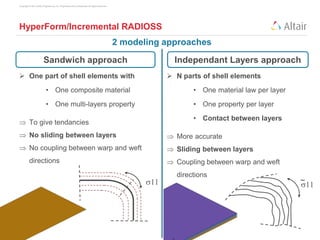




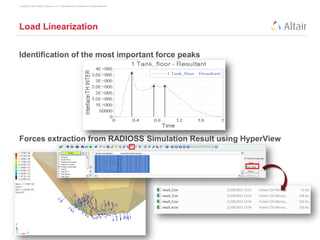
![Copyright © 2013 Altair Engineering, Inc. Proprietary and Confidential. All rights reserved.
Equivalent OS Model Set Up
MAT 8
1 PCOMPP & Laminate on each face
Each laminate composed of 4 plies
[0, 90, 45, -45]
3 Load collector corresponding for
each force’s peak
Inertia RELIEF active](https://image.slidesharecdn.com/eatc2015radioss-151113105118-lva1-app6891/85/RADIOSS-Composite-Materials-Optimization-33-320.jpg)
















